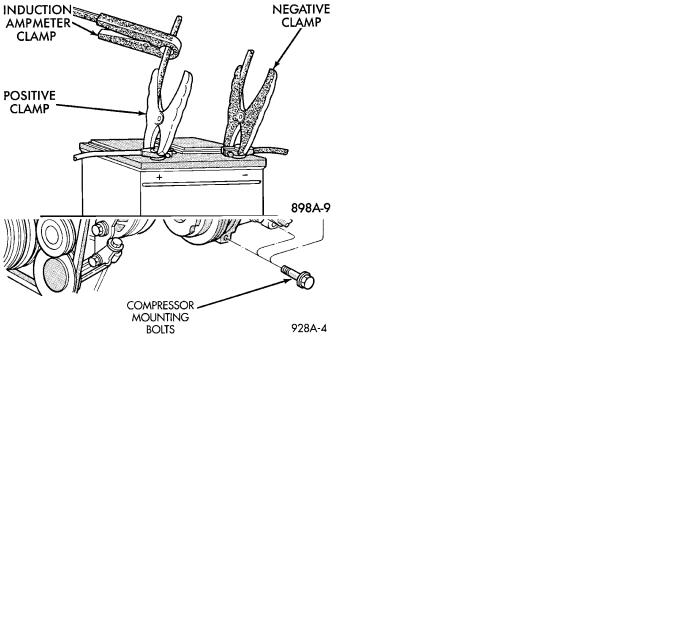
- •GENERAL INFORMATION
- •GENERAL INFORMATION
- •TEST INDICATOR
- •STATE OF CHARGE TESTS
- •USING TEST INDICATOR
- •CAUSES OF BATTERY DISCHARGING
- •ABNORMAL BATTERY DISCHARGING
- •BATTERY OPEN CIRCUIT VOLTAGE TEST
- •BATTERY LOAD TEST
- •BATTERY CHARGING
- •CHARGING TIME REQUIRED
- •CHARGING COMPLETELY DISCHARGED BATTERY
- •IGNITION OFF DRAW (IOD)
- •GENERAL INFORMATION
- •IGNITION OFF DRAW (IOD) TESTS
- •VEHICLES EQUIPPED WITH ELECTRONIC AUTOMATIC TRANSMISSION, LOAD LEVELING SUSPENSION, OR ALARM SYSTEM
- •STARTER TEST PROCEDURES ON VEHICLE
- •GENERAL INFORMATION
- •DIAGNOSTIC PREPARATION
- •STARTER FEED CIRCUIT TESTS
- •STARTER FEED CIRCUIT RESISTANCE TEST
- •STARTER CONTROL CIRCUIT TESTS
- •STARTER SOLENOID TEST
- •STARTER RELAY TEST
- •IGNITION SWITCH TEST
- •BENCH TESTING STARTER SOLENOID
- •ALTERNATOR TEST PROCEDURES ON VEHICLE
- •ALTERNATOR OUTPUT WIRE RESISTANCE TEST
- •PREPARATION
- •TEST
- •RESULTS
- •ALTERNATOR CURRENT OUTPUT TEST
- •PREPARATION
- •TEST
- •RESULTS
- •EXAMPLES:
- •DIAGNOSTIC TESTING USING FAULT CODES
- •DRB II DIAGNOSTIC TESTER
- •TESTING FAULT CODES
- •SPECIFICATIONS
- •TORQUE SPECIFICATIONS

8A - 4 BATTERY/STARTING/CHARGING SYSTEMS DIAGNOSTICS |
|
Ä |
|
|
|||
BATTERY OPEN CIRCUIT VOLTAGE TEST |
BATTERY LOAD TEST |
|
|
An open circuit voltage, no load test will show the state of charge in a battery. Also, if it will pass a load test of 50 percent of the battery cold crank rating. Refer to Battery Load Test. If a battery has an open circuit voltage reading of 12.4 volts or greater, and will not pass a load test, it is defective and replacement would be required. To test open circuit voltage, perform the following operation:
(1)Remove both battery cables, negative first. If the battery has been boosted, charged, or loaded just prior to this operation, allow the battery a few minutes to stabilize.
(2)Using a voltmeter connected to the battery posts and measure the open circuit voltage (Fig. 7).
A fully charged battery must have reserve cranking capacity. This will enable the starter motor and ignition system enough power to start the engine over a broad range of ambient temperatures. A battery load test will verify the actual cranking performance based on the cold crank rating of the battery.
WARNING: IF BATTERY SHOWS SIGNS OF FREEZING, LEAKING, LOOSE POSTS, OR EXCESSIVELY LOW ELECTROLYTE LEVEL, DO NOT TEST. ACID BURNS OR AN EXPLOSIVE CONDITION MAY RESULT.
(1)Remove both battery cables, negative first. Battery top, cables and posts should be clean. If green dot is not visible in indicator, charge the battery. Refer to Battery Charging Procedures.
(2)Use a suitable Volt Ammeter Load tester (Fig.
9)connected to the battery posts (Fig. 10). Check the open circuit voltage of the battery.
Voltage should be equal to or greater than 12.4 volts with the green dot visible in test indicator.
Fig. 7 Testing Open Circuit Voltage
This voltage reading will show the battery state of charge. It will not reveal battery cranking capacity (Fig. 8).
Fig. 9 Volt-Ammeter-Load Tester
|
Fig. 10 Volt-Ammeter-Load Tester Connections |
|
|
(3) Rotate the load control knob Carbon pile rheo- |
|
|
stat to apply a 300 amp load. Apply this load for 15 |
|
Fig. 8 Battery Open Circuit Voltage |
seconds to remove the surface charge from the bat- |
|
tery, and return the control knob to off (Fig. 11). |
||
|
